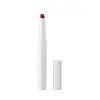Yves Saint Laurent Rouge Volupte Shine Lipstick Balm Versus KVD Vegan Beauty Epic Kiss Nourishing Vegan Butter Lipstick
What's inside
What's inside
 Key Ingredients
Key Ingredients

 Benefits
Benefits

 Concerns
Concerns

 Ingredients Side-by-side
Ingredients Side-by-side

Propylene Glycol Dibenzoate
Skin ConditioningOctyldodecanol
EmollientStearyl/PPG-3 Myristyl Ether Dimer Dilinoleate
EmollientPentaerythrityl Tetraisostearate
EmollientNeopentyl Glycol Diheptanoate
EmollientBis-Diglyceryl Polyacyladipate-2
EmollientPolyethylene
AbrasiveCera Microcristallina
Emulsion StabilisingPolybutene
Hydrogenated Coco-Glycerides
EmollientCandelilla Cera
EmollientSilica
AbrasiveSynthetic Fluorphlogopite
Alumina
AbrasiveMagnesium Silicate
AbsorbentPentaerythrityl Tetra-Di-T-Butyl Hydroxyhydrocinnamate
AntioxidantCalcium Aluminum Borosilicate
Polyurethane-15
Calcium Sodium Borosilicate
Aluminum Hydroxide
EmollientColophonium
Tin Oxide
AbrasivePolyethylene Terephthalate
Acrylates Copolymer
Parfum
MaskingMica
Cosmetic ColorantCI 77891
Cosmetic ColorantCI 77491
Cosmetic ColorantCI 77492
Cosmetic ColorantCI 77499
Cosmetic ColorantCI 45410
Cosmetic ColorantCI 15850
Cosmetic ColorantCI 15985
Cosmetic ColorantCI 45380
Cosmetic ColorantCI 19140
Cosmetic ColorantCI 77742
Cosmetic ColorantCI 77120
Cosmetic ColorantCI 42090
Cosmetic ColorantCI 75470
Cosmetic ColorantPropylene Glycol Dibenzoate, Octyldodecanol, Stearyl/PPG-3 Myristyl Ether Dimer Dilinoleate, Pentaerythrityl Tetraisostearate, Neopentyl Glycol Diheptanoate, Bis-Diglyceryl Polyacyladipate-2, Polyethylene, Cera Microcristallina, Polybutene, Hydrogenated Coco-Glycerides, Candelilla Cera, Silica, Synthetic Fluorphlogopite, Alumina, Magnesium Silicate, Pentaerythrityl Tetra-Di-T-Butyl Hydroxyhydrocinnamate, Calcium Aluminum Borosilicate, Polyurethane-15, Calcium Sodium Borosilicate, Aluminum Hydroxide, Colophonium, Tin Oxide, Polyethylene Terephthalate, Acrylates Copolymer, Parfum, Mica, CI 77891, CI 77491, CI 77492, CI 77499, CI 45410, CI 15850, CI 15985, CI 45380, CI 19140, CI 77742, CI 77120, CI 42090, CI 75470
Polybutene
Octyldodecanol
EmollientCoco-Caprylate/Caprate
EmollientPolyethylene
AbrasiveDiisostearyl Malate
EmollientIsononyl Isononanoate
EmollientBis-Diglyceryl Polyacyladipate-2
EmollientHydrogenated Polydecene
EmollientCera Microcristallina
Emulsion StabilisingTheobroma Grandiflorum Seed Butter
Skin ConditioningMorus Alba Leaf Extract
Skin ConditioningHelianthus Annuus Seed Oil
EmollientCarthamus Tinctorius Seed Oil
MaskingHydrogenated Styrene/Isoprene Copolymer
Aroma
Pentaerythrityl Tetra-Di-T-Butyl Hydroxyhydrocinnamate
AntioxidantDicalcium Phosphate
AbrasiveSqualane
EmollientEthyl Vanillin
MaskingSilica
AbrasiveTocopherol
AntioxidantIron Oxides
CI 15850
Cosmetic ColorantCI 77891
Cosmetic ColorantPolybutene, Octyldodecanol, Coco-Caprylate/Caprate, Polyethylene, Diisostearyl Malate, Isononyl Isononanoate, Bis-Diglyceryl Polyacyladipate-2, Hydrogenated Polydecene, Cera Microcristallina, Theobroma Grandiflorum Seed Butter, Morus Alba Leaf Extract, Helianthus Annuus Seed Oil, Carthamus Tinctorius Seed Oil, Hydrogenated Styrene/Isoprene Copolymer, Aroma, Pentaerythrityl Tetra-Di-T-Butyl Hydroxyhydrocinnamate, Dicalcium Phosphate, Squalane, Ethyl Vanillin, Silica, Tocopherol, Iron Oxides, CI 15850, CI 77891
 Reviews
Reviews

Ingredients Explained
These ingredients are found in both products.
Ingredients higher up in an ingredient list are typically present in a larger amount.
This ingredient is lipid-based synthetic skin-conditioning agent derived from adipic acid and a mixture of fatty acids. It is often called a lanolin substitute.
As an emollient, it helps soften and hydrate the skin. Emollients create a barrier on the skin to trap moisture in.
Due to its fatty acid base, it may not be Malassezia folliculitis safe.
Learn more about Bis-Diglyceryl Polyacyladipate-2Cera Microcristallina isn't fungal acne safe.
Ci 15850 is the pigment color red. It is an azo dye and created synthetically.
Azo dyes need to be thoroughly purified before use. This allows them to be more stable and longer-lasting.
This ingredient is common in foundations, lipsticks, and blushes. This color is described as brown/orangey red.
It has many secondary names such as Red 6 and Red 7. According to a manufacturer, Red 6 usually contains aluminum.
Learn more about CI 15850Ci 77891 is a white pigment from Titanium dioxide. It is naturally found in minerals such as rutile and ilmenite.
It's main function is to add a white color to cosmetics. It can also be mixed with other colors to create different shades.
Ci 77891 is commonly found in sunscreens due to its ability to block UV rays.
Learn more about CI 77891Octyldodecanol is a fatty alcohol. It is primarily used to enhance the texture of products.
As an emulsifier, Octyldodecanol helps prevent the oils and waters from separating. It also prevents ingredients from creating foam when shaken.
Octyldodecanol is created by reducing fatty acid to an alcohol.
Due to its high molecular weight, it does not get absorbed into the skin.
Learn more about OctyldodecanolPentaerythrityl Tetra-Di-T-Butyl Hydroxyhydrocinnamate (long name, huh?) is a synthetic antioxidant.
It is used to help stabilize other antioxidants or prevent the color from changing in a product.
As an antioxidant, it helps fight free-radical molecules. Free-radical molecules are capable of damaging our cells and other genetic material. Thus, antioxidants may reduce the signs of aging.
This ingredient is oil-soluble.
Learn more about Pentaerythrityl Tetra-Di-T-Butyl HydroxyhydrocinnamatePolybutene is used to help control the viscosity of a product. This just means it helps adjusts the texture.
It is a polymer and does not get absorbed into the skin due to its large size.
Studies found this ingredient did not irritate skin in concentrations below 15%.
Learn more about PolybutenePolyethylene is a synthetic ingredient that helps the skin retain moisture. It is a polymer.
It is also typically used within product formulations to help bind solid ingredients together and thicken oil-based ingredients. When added to balms and emulsions, it helps increase the melting point temperature.
Silica, also known as silicon dioxide, is a naturally occurring mineral. It is used as a fine, spherical, and porous powder in cosmetics.
Though it has exfoliant properties, the function of silica varies depending on the product.
The unique structure of silica enhances the spreadability and adds smoothness, making it a great texture enhancer.
It is also used as an active carrier, emulsifier, and mattifier due to its ability to absorb excess oil.
In some products, tiny microneedles called spicules are made from silica or hydrolyzed sponge. When you rub them in, they lightly polish away dead skin layers and enhance the penetration of active ingredients.
Learn more about Silica